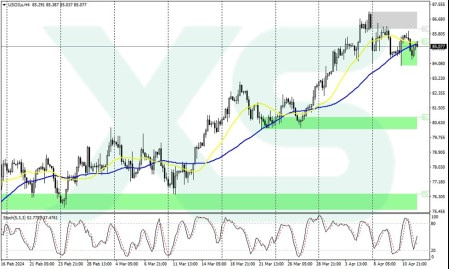Crude oil (WTI) is trading at $85.10 at the beginning of trading today, Friday. Oil prices have dipped following OPEC’s monthly report, where the group issued a warning that it will closely monitor the oil market balance amid an expected demand surge during the summer.
On the geopolitical front, U.S. intelligence has forecasted escalating attacks from Iran on Israeli or American targets in the Middle East in response to attacks in Damascus.
However, the Houthi rebels in Yemen are targeting ships in the Gulf of Aden and attacking a U.S. destroyer, heightening concerns about supply shortages.
Additionally, the U.S. dollar remains strong after the European Central Bank confirmed its intention to cut interest rates in June.
U.S. Producer Price Index (PPI) figures were in line with or lower than expectations, diminishing the strength of the U.S. dollar, which was based on the idea that all inflationary elements would continue to rise or remain high.
From my perspective, March inflation data will influence market expectations regarding the Federal Reserve’s pivot to interest rate cuts in the June meeting. I anticipate stubborn inflation data due to rising oil prices, rents, insurance costs, and portfolio management fees.
OPEC’s monthly report also conveys a message that OPEC will closely monitor the summer and intervene as needed, with hints of ending production cuts if necessary. Mexican oil exports remain steady, despite not recovering from their March decline to their lowest levels since 2019. Occidental Petroleum is set to resume production in the Gulf of Mexico after an earlier pipeline leak.
Saudi Aramco has announced it will deliver full contractual quantities to Asian consumers. It appears to me that global supply and demand are very close, indicating a fragile balance in the markets, so I believe there could be a slight increase in oil prices once this balance collapses.
From a geopolitical standpoint, U.S. intelligence believes Iran is poised to carry out major drone and missile strikes, despite recent statements by Iranian officials that they will not escalate tensions and are not interested in sparking a war in the region.
From my perspective, escalating tensions in the Middle East keep demand unchanged. This led to a correction in oil prices after reaching a new five-month high at $87.50. Therefore, the prevailing concerns here are direct Iranian intervention in the Israeli-Palestinian conflict, with the Israeli army announcing its readiness to invade Rafah, the last refuge for displaced Palestinians, and I do not think they will intervene under any circumstances.
However, if Iran enters the war in Gaza, it will significantly disrupt the oil supply chain. As the third-largest oil producer in OPEC, its direct involvement in the war will lead to significant movements in the oil market and have a positive impact on oil prices.
At the same time, Ukrainian drone attacks on Russian oil infrastructure continue to fuel concerns of oil supply disruptions, supporting the upward trend in prices in the near and medium term.
Technical Analysis of the Oil (WTI) Prices:
Oil prices are surging higher as tensions escalate in the Middle East, taking on new shapes and movements. With Iran vowing to retaliate against Israel or any American assets in the region, any escalation in tensions will be seen as a dark tunnel the region will enter entirely, with the prospect of a long-term conflict and the risk of oil supply disruption. All these elements are enough for traders to price in a further increase in crude oil, which may approach $90 in the medium term.

Oil (WTI) – Prices Chart –-XS.com MT4.
On the chart, if the recent high of $87.12 is breached, the price could test the $90 level. However, resistance at $89.64 will impede progress in the near term. In the event of escalating tensions in the Middle East, we expect $94 to be the logical price target, marking a new 18-month high.
On the downside, $83.34 is considered the support level that must be broken to target $80.63, a stubborn major support. Additionally, the convergence of the 55-day and 200-day simple moving averages at $79.32 is likely to halt any further price declines.
Support levels: $84.47 – $84.05 – $83.25
Resistance levels: $85.83 – $85.83 – $86.60



